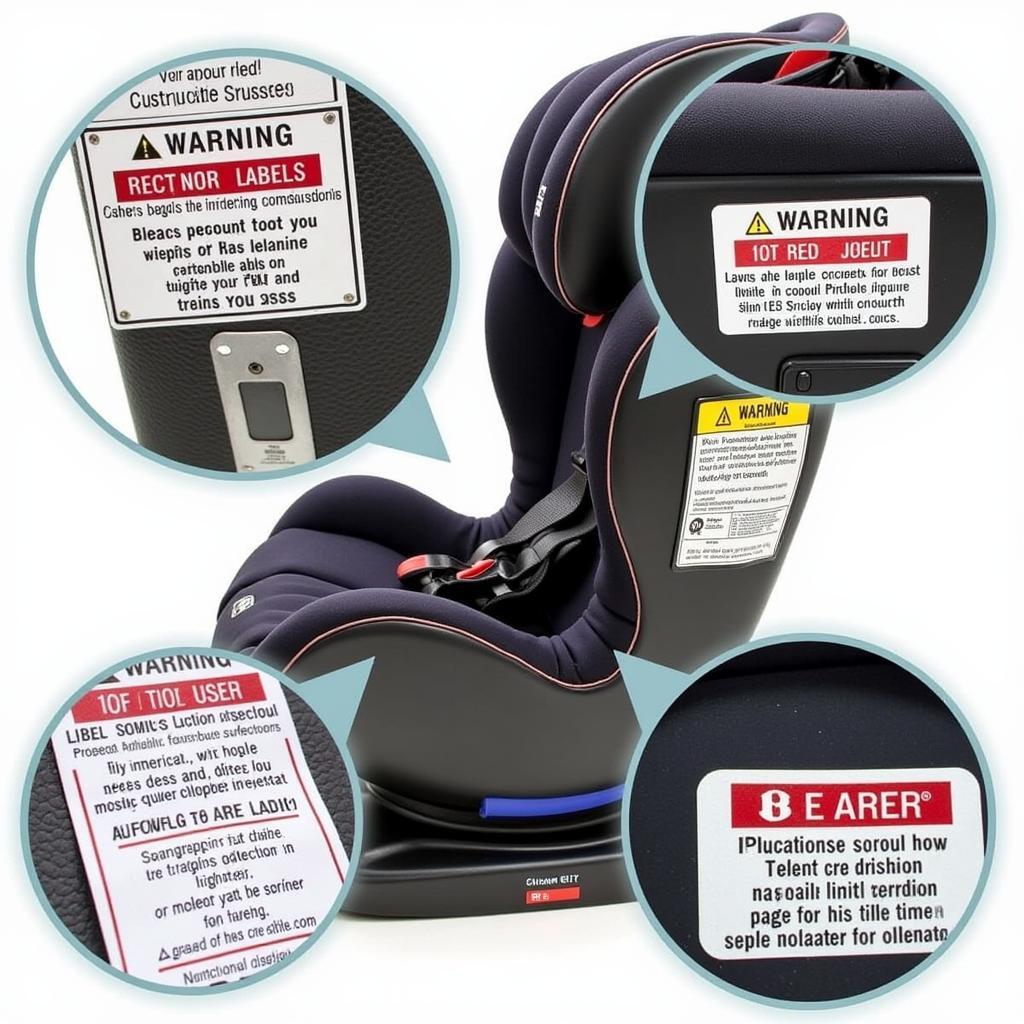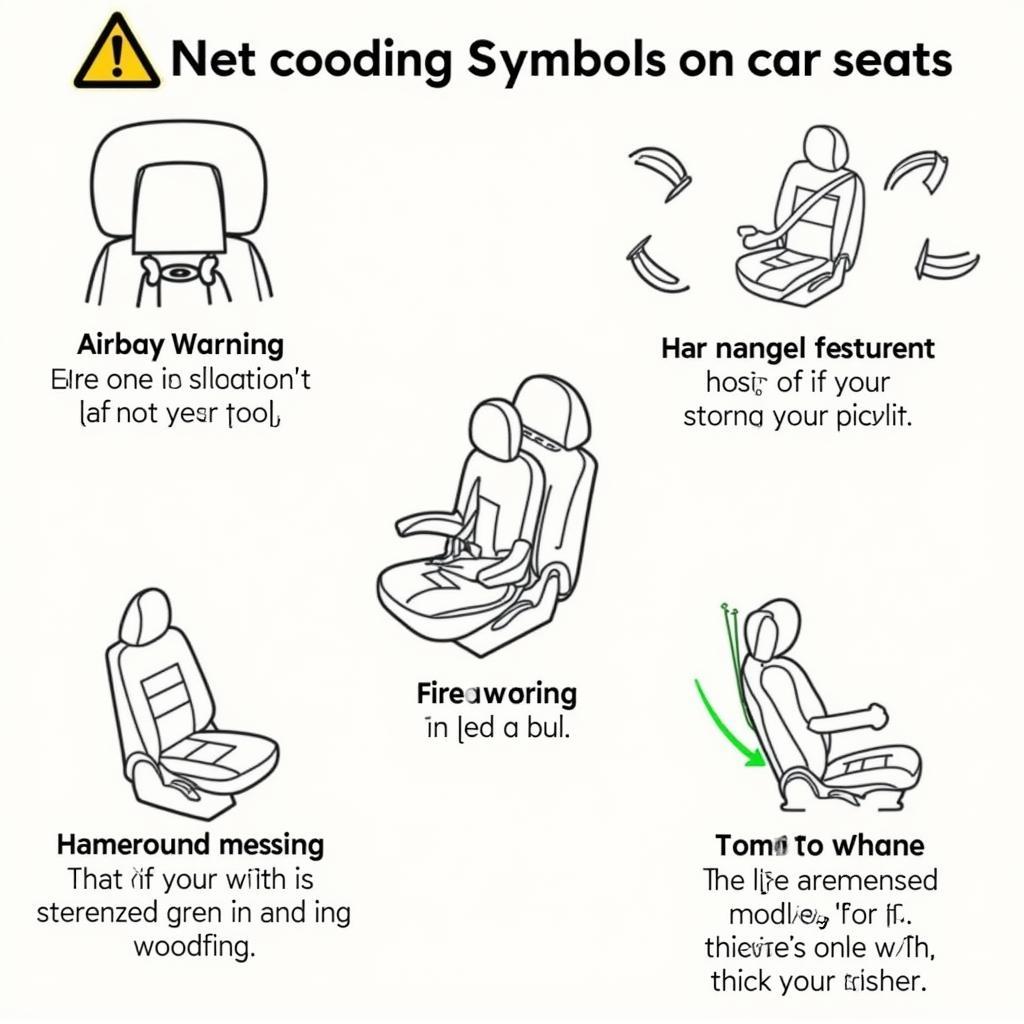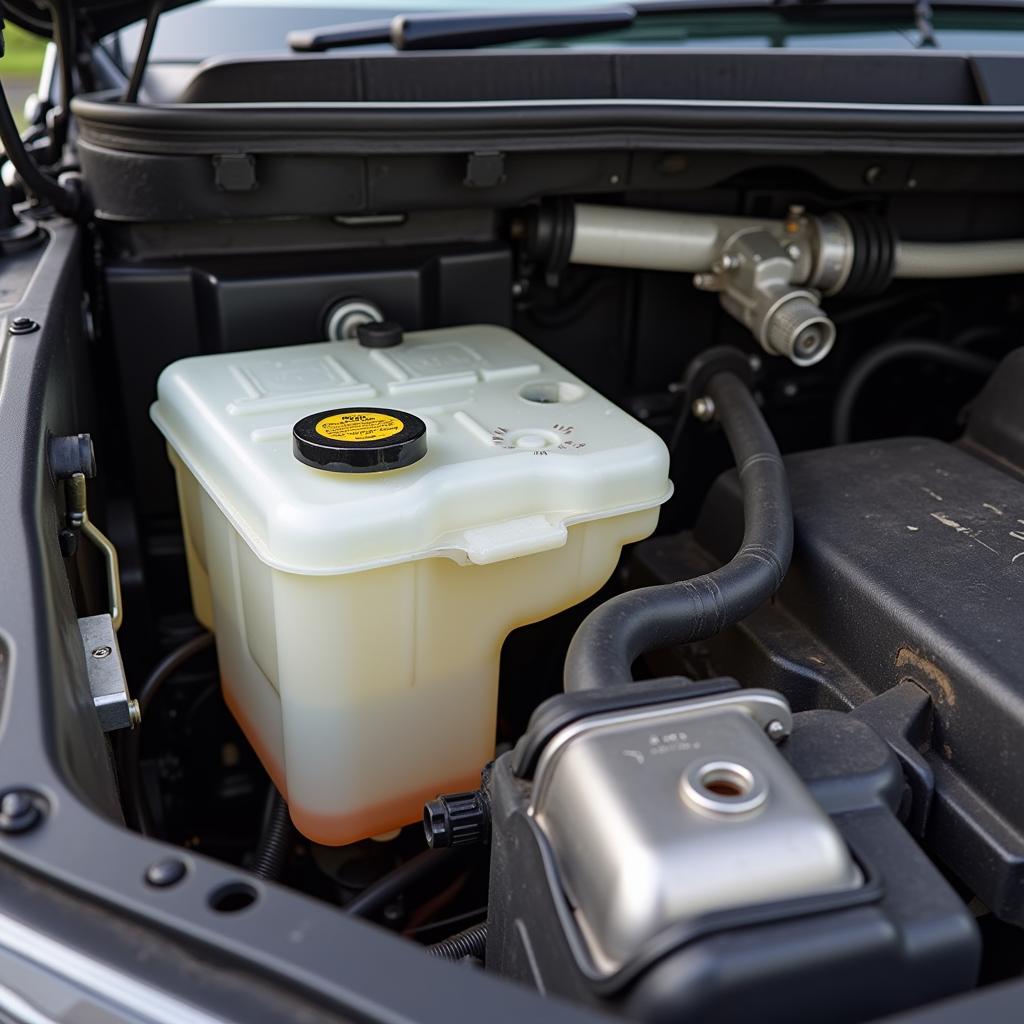Car seat warning labels. They might seem like a jumble of words and symbols, easily ignored in the flurry of getting your little one strapped in safely. But these labels are far more than just legal jargon. They’re your lifeline to vital safety information, carefully crafted to protect your most precious cargo.
 Car Seat Warning Label Placement
Car Seat Warning Label Placement
Deciphering the Code: Understanding Warning Label Language
Car seat warning labels can appear in different formats, from simple text to pictograms and symbols. Each label serves a specific purpose, addressing potential hazards, installation instructions, or usage guidelines.
- Warning vs. Caution: “Warning” labels highlight serious safety concerns that could lead to severe injury or death if ignored. “Caution” labels point towards potential risks or misuse that might result in minor injuries or damage to the car seat.
- Symbols and Pictograms: These visual aids transcend language barriers, offering a universally understandable representation of critical warnings. For instance, a crossed-out airbag symbol indicates that a car seat should not be used in that particular seating position.
- Legibility is Key: Manufacturers are obligated to ensure the warning labels are clear, durable, and remain legible throughout the car seat’s lifespan. If you encounter faded or damaged labels, refer to the manufacturer’s website for replacements or contact them directly.
Crucial Information on Car Seat Warning Labels
Car seat warning labels are strategically placed to capture your attention during installation and use. They hold crucial information pertaining to:
- Car Seat Model and Manufacturing Date: This information helps determine if your car seat complies with current safety standards and if it’s affected by any recalls.
- Weight and Height Limits: Exceeding these limits can compromise the car seat’s structural integrity and your child’s safety during a crash or sudden stop.
- Installation Instructions: Different car seats have specific installation methods, whether using LATCH systems, seat belts, or a combination of both. The warning labels provide step-by-step guidance and diagrams for secure installation.
- Harness Adjustment: Correct harness positioning is critical for optimal protection. Warning labels guide you on harness slot placement based on your child’s height and weight, ensuring a snug and secure fit.
- Airbag Safety: Labels clearly indicate if a car seat can be used in a front passenger seat equipped with an airbag. Never place a rear-facing car seat in the front passenger seat if the airbag is active.
- Cleaning and Care Instructions: Proper cleaning ensures the car seat’s longevity and hygiene. Labels often specify suitable cleaning materials and methods to avoid damaging the seat’s fabric or structural components.
 Common Car Seat Warning Symbols
Common Car Seat Warning Symbols
Why Ignoring Car Seat Warning Labels is a Gamble You Can’t Afford
Ignoring car seat warning labels puts your child at an unacceptable risk. Here’s why:
- Increased Risk of Injury: Improper installation or incompatible car seat placement can significantly increase the chances of severe injury or fatality in a crash.
- Voided Warranty: Failing to adhere to the manufacturer’s instructions, including those mentioned on warning labels, can void the car seat’s warranty, leaving you without coverage in case of defects or malfunctions.
- Legal Consequences: In many jurisdictions, using a car seat incorrectly or disregarding safety regulations is a punishable offense that can lead to fines or other penalties.
Beyond the Labels: Seeking Additional Guidance
Car seat warning labels are your first line of defense, but don’t hesitate to seek additional support when needed. Certified car seat technicians can provide personalized assistance with installation, ensuring your car seat is correctly fitted for your child and your vehicle.
You can find certified technicians through local fire departments, hospitals, or online resources like the National Highway Traffic Safety Administration (NHTSA) website.
britax car seat warning labels provide specific guidelines for their car seats, ensuring optimal safety for your child.
Conclusion: Making Informed Decisions for Your Child’s Safety
Car seat warning labels are not mere suggestions; they are crucial safety guidelines designed to protect your most precious cargo. By understanding their significance and diligently following their instructions, you’re taking a proactive step towards ensuring your child travels safely and securely.
Remember, when it comes to your child’s safety, there’s no room for shortcuts or assumptions. Take the time to decipher those labels, seek expert help when needed, and drive with confidence knowing you’ve done everything to keep your little one safe on the road.
FAQs
1. What should I do if a warning label on my car seat is damaged or illegible?
Contact the car seat manufacturer directly or visit their website. They will likely provide you with replacement labels or guide you to resources where you can obtain them.
2. My car seat is older and doesn’t have all the same warning labels as newer models. Is it still safe to use?
Check the manufacturer’s website or contact them directly to confirm if your car seat model has been recalled or if there are any safety advisories related to it. It’s always advisable to use car seats that meet the latest safety standards.
3. Can I wash my car seat cover in the washing machine?
Refer to the cleaning instructions on your specific car seat’s warning labels. Some manufacturers allow machine washing with specific settings, while others recommend hand washing to prevent damage to the car seat’s materials.
4. I’m unsure if my car seat is compatible with my car’s seat belt system. Where can I find this information?
The car seat’s instruction manual and warning labels should provide guidance on compatible seat belt systems. You can also check the vehicle manufacturer’s manual for information on using child restraint systems in your car model.
5. My child seems uncomfortable in their car seat even though it’s installed correctly. What could be the issue?
Ensure that you are using the correct harness slots for your child’s height and weight as indicated on the warning labels. Additionally, make sure the harness straps are snug but not overly tight, allowing for one finger’s width of slack.
are thir car seats without warning sticker can pose serious safety risks as they may not meet essential safety regulations. Always ensure you are using a car seat with clear and intact warning labels.

